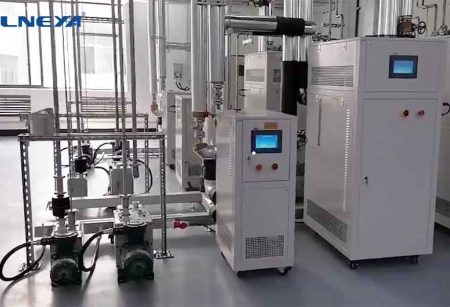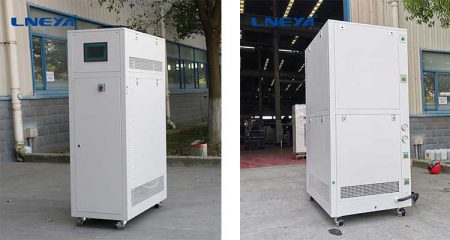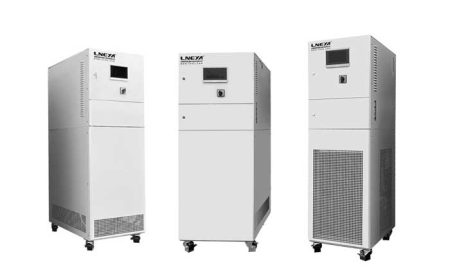Waste Heat Chiller
Structure of waste heat chiller
Waste heat chiller usually consists of components such as heat exchanger, compressor, condenser, throttle valve and evaporator. Among them, the heat exchanger is the core component and is used in the refrigeration process to convert waste heat into refrigerant. The compressor compresses the low-pressure refrigerant into a high-temperature and high-pressure state, and sends it to the heat exchanger to exchange heat with the cooled waste heat. After cooling, the refrigerant enters the evaporator through the throttle valve, and absorbs heat in the evaporator to cause the surrounding medium to The temperature is reduced to achieve the purpose of refrigeration.

The principle of waste heat chiller
The refrigeration principle of waste heat chiller is based on the principle of thermodynamics, which is a refrigeration process that converts waste heat into refrigerant through a heat exchanger. When a waste heat source exists, the coolant in the heat exchanger exchanges heat with the waste heat, converting the waste heat into a refrigeration process. At the same time, the compressor compresses the low-pressure refrigerant into a high-temperature and high-pressure state, and sends it to the heat exchanger to exchange heat with the cooled waste heat. After the refrigerant is cooled, it enters the evaporator through the throttle valve, absorbs heat in the evaporator, and makes the surrounding environment cool. The temperature of the medium is reduced, thereby achieving the purpose of refrigeration.
The first step is waste heat recovery. In the industrial production process, a large amount of waste heat is often generated, which can be recovered through the waste heat recovery system. The waste heat recovery system usually consists of a waste heat exchanger, a waste heat recovery device, a waste heat storage device, etc., through which high-temperature waste heat is converted into low-temperature refrigeration.
The second step is refrigerant circulation. Refrigerant is an important part of the waste heat refrigeration system. The refrigeration effect is achieved through circulating flow. The refrigerant cycle includes four processes: evaporation, compression, condensation and expansion. During the evaporation process, the refrigerant absorbs heat from the low-temperature evaporator and becomes a gas; during the compression process, the refrigerant is compressed into a high-temperature and high-pressure gas; during the condensation process, the refrigerant dissipates heat through the condenser and becomes a liquid :During the expansion process, the refrigerant reduces the pressure through the expansion valve and becomes a low-temperature and low-pressure gas.
The third step is the cooling effect. Through waste heat recovery and refrigerant circulation, the waste heat refrigeration system can achieve cooling effects. During the refrigeration process, the refrigerant absorbs heat from the low-temperature evaporator and takes the heat away to achieve the refrigeration effect. The size of the refrigeration effect depends on factors such as the type of refrigerant, temperature and pressure.

The waste heat chiller has the following advantages:
1. Energy saving: The waste heat chiller uses waste heat for cooling without consuming additional energy.
2. Environmentally friendly: waste heat chiller does not use any harmful substances and will not produce any pollution.
3. High efficiency: The cooling efficiency of the waste heat chiller depends on the temperature and amount of the waste heat source, so it can cool efficiently.
Ofrecemos diseño y fabricación de sistemas completos de control de temperatura. Desde modelos estándar hasta productos personalizados completos de hasta 900 toneladas. Nos especializamos en el servicio al cliente y nos dedicamos a ayudar a cada cliente a tener el sistema de control de temperatura óptimo para su necesidad específica.
Ofrecemos soluciones personalizadas no estándar. Disponemos tanto de enfriadoras individuales como de unidades combinadas de refrigeración y calefacción.
Correo electrónico: info@lneya.com WeChat ID: +8615251628237 WhatsApp: +86 17851209193

Enfriadoras de recirculación / Criotermostatos
El enfriador puede utilizarse ampliamente en diversas industrias y laboratorios, y admite diseños personalizados.
| Temperatura | Serie -25°C ~ +30°C | Serie -45°C ~ +30°C | Serie -60°C ~ -20°C | Serie -80°C ~ -20°C | Serie -120°C ~ -70°C | ||||
| Capacidad de refrigeración | 0,8 ~ 30 kW | 0,75 ~ 12 kW | 0,4 ~ 6kW | 0,2 ~ 6kW | 0,3 ~ 5kW | ||||
| Nota: Se puede personalizar cualquier rango de temperatura de -150℃ ~ +350℃ y cualquier capacidad de refrigeración. | |||||||||
 Enfriadoras de agua / Enfriadoras pequeñas
Enfriadoras de agua / Enfriadoras pequeñas
El enfriador puede utilizarse ampliamente en diversas industrias y laboratorios, y admite diseños personalizados.
| Temperatura | -18°C ~ +30°C | Serie +5°C ~ +35°C | |||||||
| Capacidad de refrigeración | 0,35 ~ 0,9 kW | 1,8 ~ 50 kW | |||||||
| Nota: Se puede personalizar cualquier rango de temperatura de -150℃ ~ +350℃ y cualquier capacidad de refrigeración. | |||||||||

Refrigeradores de baja temperatura
Estamos especializados en la producción de refrigeradores de baja temperatura con un rango de control de temperatura de hasta -150°C, que pueden satisfacer las necesidades de refrigeración de diferentes industrias.
| Temperatura | Serie -25°C ~ -5°C | Serie -45°C ~ -10°C | Serie -60°C ~ -10°C | Serie -80°C ~ -30°C | Serie -110°C ~ -50°C | Serie -150°C ~ -110°C | |||
| Capacidad de refrigeración | 12 ~ 360 kW | 6 ~ 180 kW | 6 ~ 180 kW | 4 ~ 180kW | 2 ~ 120kW | 2,5 ~ 11 kW | |||
| Nota: Se puede personalizar cualquier rango de temperatura de -150℃ ~ +350℃ y cualquier capacidad de refrigeración. | |||||||||

Refrigeradores de alta temperatura
El enfriador puede utilizarse ampliamente en diversas industrias y laboratorios, y admite diseños personalizados.
| Temperatura | +5°C ~ +40°C | -25°C ~ +40°C | -45°C ~ +40°C | -80°C ~ +80°C | -100°C ~ +80°C | ||||
| Capacidad de refrigeración | 6 ~ 40kW | 2 ~ 15kW | 1 ~ 8kW | 0,6 ~ 3 kW | 1,5 ~ 3 kW | ||||
| Nota: Se puede personalizar cualquier rango de temperatura de -150℃ ~ +350℃ y cualquier capacidad de refrigeración. | |||||||||

Enfriadoras y calefactoras
Rango de control de temperatura: -120°C a +350°C
termostato de refrigeración y calefacción, ampliamente utilizado en diversas industrias.
| Temperatura | Serie -10 ~ +150°C | Serie -25 ~ +200°C | Serie -25 ~ +300°C | Serie -45 ~ +250°C | Serie -45 ~ +300°C | Serie -60 ~ +250°C | Serie -60 ~ +300°C | Serie -70 ~ +250°C | Serie -80 ~ +250°C | Serie -90 ~ +250°C | Serie -100 ~ +100°C | ||
| Capacidad de refrigeración | 1,5 ~ 15 kW | 1 ~ 200 kW | 1 ~ 200 kW | 0,45 ~ 200 kW | 0,9 ~ 25 kW | 0,25 ~ 60 kW | 0,75 ~ 25 kW | 0,4 ~ 15 kW | 0,3 ~ 80 kW | 0,2 ~ 80 kW | 0,45 ~ 80 kW | ||
| Nota: Se puede personalizar cualquier rango de temperatura de -150℃ ~ +350℃ y cualquier capacidad de refrigeración. | |||||||||||||

Enfriadoras de recirculación
Rango de control de temperatura: -45°C a +250°C
| Temperatura | Serie -25°C ~ +200°C | Serie -45°C ~ +250°C | |||||||
| Capacidad de refrigeración | 1 ~ 15 kW | 0,25 ~ 15 kW | |||||||
| Nota: Se puede personalizar cualquier rango de temperatura de -150℃ ~ +350℃ y cualquier capacidad de refrigeración. | |||||||||
 LNEYA
LNEYA
 简体中文
简体中文


















































































